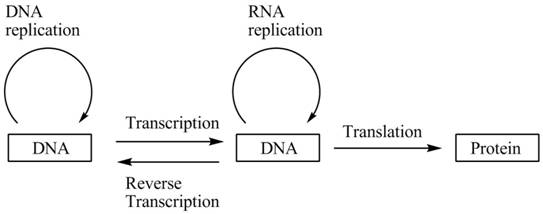
Concept explainers
Does the term gene expression refer to:
(a) transcription, (b) translation, or (c) transcription
plus translation?
Interpretation:
The term gene expression refers to transcription, translation or transcription plus translation is to be determined.
Concept Introduction:
A biological process in which the information present in DNA is copied to RNA (mRNA) is known as transcription. The initiation of transcription takes place in the presence of RNA polymerase. A biological process in which the information present on mRNA is copied to tRNA is known as translation. The formation of protein takes place during translation.
Answer to Problem 26.5P
Correct answer:
The correct option is (c).
Explanation of Solution
Reason for correct option:
(c) The synthesis of protein by the use of genetic information from DNA is termed as gene expression. In the other words, activation of genes takes place during gene expression. The information from DNA is transferred to mRNA (transcription) which further transfers it to tRNA (translation) where synthesis of protein takes place.
The activation of gene takes place in two steps, transcription and translation as shown below.

Figure 1.
Reasons for incorrect options:
(a) The synthesis of protein by the use of genetic information from DNA is termed as gene expression. Protein is not synthesized during transcription. Hence, term gene expression does not refer to transcription.
(b) The synthesis of protein by the use of genetic information from DNA is termed as gene expression. The formation of protein does not start from translation. Hence, term gene expression does not refer to translation.
Want to see more full solutions like this?
Chapter 26 Solutions
Introduction to General, Organic and Biochemistry
 Chemistry for Today: General, Organic, and Bioche...ChemistryISBN:9781305960060Author:Spencer L. Seager, Michael R. Slabaugh, Maren S. HansenPublisher:Cengage Learning
Chemistry for Today: General, Organic, and Bioche...ChemistryISBN:9781305960060Author:Spencer L. Seager, Michael R. Slabaugh, Maren S. HansenPublisher:Cengage Learning General, Organic, and Biological ChemistryChemistryISBN:9781285853918Author:H. Stephen StokerPublisher:Cengage Learning
General, Organic, and Biological ChemistryChemistryISBN:9781285853918Author:H. Stephen StokerPublisher:Cengage Learning Organic And Biological ChemistryChemistryISBN:9781305081079Author:STOKER, H. Stephen (howard Stephen)Publisher:Cengage Learning,
Organic And Biological ChemistryChemistryISBN:9781305081079Author:STOKER, H. Stephen (howard Stephen)Publisher:Cengage Learning, World of Chemistry, 3rd editionChemistryISBN:9781133109655Author:Steven S. Zumdahl, Susan L. Zumdahl, Donald J. DeCostePublisher:Brooks / Cole / Cengage Learning
World of Chemistry, 3rd editionChemistryISBN:9781133109655Author:Steven S. Zumdahl, Susan L. Zumdahl, Donald J. DeCostePublisher:Brooks / Cole / Cengage Learning World of ChemistryChemistryISBN:9780618562763Author:Steven S. ZumdahlPublisher:Houghton Mifflin College DivChemistry: Matter and ChangeChemistryISBN:9780078746376Author:Dinah Zike, Laurel Dingrando, Nicholas Hainen, Cheryl WistromPublisher:Glencoe/McGraw-Hill School Pub Co
World of ChemistryChemistryISBN:9780618562763Author:Steven S. ZumdahlPublisher:Houghton Mifflin College DivChemistry: Matter and ChangeChemistryISBN:9780078746376Author:Dinah Zike, Laurel Dingrando, Nicholas Hainen, Cheryl WistromPublisher:Glencoe/McGraw-Hill School Pub Co





